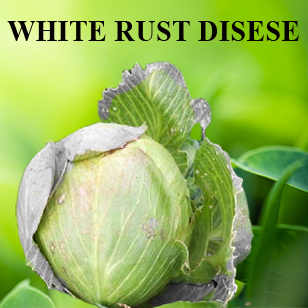
White Rust of Crucifers is due to
(a)Albugo candida / Cystopus candidus
(b)Cercospora personata
(c)Colletotrichum falcatum
(d)Pythium debaryanum
Answer
479.1k+ views
Hint: The causative organism belongs to the genus of plant-parasitic fungus called water molds. These are called the fungus-like eukaryotic organisms because they show similarity in morphology and lifestyle.
Complete answer:
Albugo candida commonly called white rust is a species of oomycete in the family Albuginaceae. It is responsible for the white rust disease in crucifers.
White rust or blisters disease is one of the most common diseases found in crucifers. Its distribution is worldwide. It affects many of crucifer’s crops of economic importance like Radish, Mustard, cabbage, etc.
Additional Information: Although it is considered unimportant in proportion to its widespread occurrence, the disease can cause serious damage to the crop leading to the losses of malformed floral parts and no formation of the seed.
-the disease affects the aerial parts of the plant, which are stems, leaves, and inflorescence, the roots remain un attacked, it appears as a mass of white pustules.
- Due to hypertrophy and hyperplasia of floral parts. the swelling along with distortion can be seen.
- The peduncle and pedicel get thickened up to 12 -15 times from the normal size, floral parts appear fleshy, swollen, green, or violet in color and the stamens start falling off early.

So, the correct answer is,’ Albugo candida / Cystopus candidus.’
Note: The infection can be classified as 2 types – Local and systemic.
In case of local infection, isolated spots or pustules appear on the leaves and other aerial parts. The size of the pustules varies from 1-2 mm in diameter and appears as raised in shiny white areas.
In systemic infections, young stems, inflorescence are infected, the pathogen becomes systemic and affects the tissue causing malformed parts.
Complete answer:
Albugo candida commonly called white rust is a species of oomycete in the family Albuginaceae. It is responsible for the white rust disease in crucifers.
White rust or blisters disease is one of the most common diseases found in crucifers. Its distribution is worldwide. It affects many of crucifer’s crops of economic importance like Radish, Mustard, cabbage, etc.
Additional Information: Although it is considered unimportant in proportion to its widespread occurrence, the disease can cause serious damage to the crop leading to the losses of malformed floral parts and no formation of the seed.
-the disease affects the aerial parts of the plant, which are stems, leaves, and inflorescence, the roots remain un attacked, it appears as a mass of white pustules.
- Due to hypertrophy and hyperplasia of floral parts. the swelling along with distortion can be seen.
- The peduncle and pedicel get thickened up to 12 -15 times from the normal size, floral parts appear fleshy, swollen, green, or violet in color and the stamens start falling off early.

So, the correct answer is,’ Albugo candida / Cystopus candidus.’
Note: The infection can be classified as 2 types – Local and systemic.
In case of local infection, isolated spots or pustules appear on the leaves and other aerial parts. The size of the pustules varies from 1-2 mm in diameter and appears as raised in shiny white areas.
In systemic infections, young stems, inflorescence are infected, the pathogen becomes systemic and affects the tissue causing malformed parts.
Recently Updated Pages
Full Form of IASDMIPSIFSIRSPOLICE class 7 social science CBSE

In case of conflict between fundamental rights of citizens class 7 social science CBSE

Can anyone list 10 advantages and disadvantages of friction

What are the Components of Financial System?

Complete the letter given below written to your Principal class null english null

Express the following as a fraction and simplify a class 7 maths CBSE

Trending doubts
Chandbardai was a state poet in the court of which class 8 social science CBSE

Who commanded the Hector the first British trading class 8 social science CBSE

Alla Rakha was an exponent of which of the following class 8 social science CBSE

How many wives and sons did Chandragupta Maurya have class 8 social science CBSE

What led to the incident of Bloody Sunday in Russia class 8 social science CBSE

Write the following in HinduArabic numerals XXIX class 8 maths CBSE




